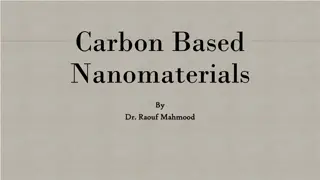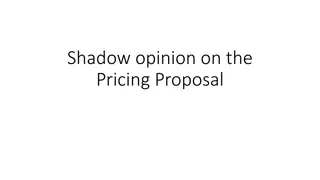Understanding CBAM: Perspectives on the Controversial Carbon Pricing Policy
The article delves into the contentious trade tool CBAM, focusing on its impact from various perspectives such as the EU, driver of CBAM, exporting countries, and challenges related to data sharing. It discusses how CBAM aims to balance carbon pricing norms for imported goods, the phasing out of free allowances, and the concerns regarding its effects on developing countries. Additionally, it explores the breach of compositeness principles and the implications for smaller firms in light of this policy.
Download Presentation

Please find below an Image/Link to download the presentation.
The content on the website is provided AS IS for your information and personal use only. It may not be sold, licensed, or shared on other websites without obtaining consent from the author. Download presentation by click this link. If you encounter any issues during the download, it is possible that the publisher has removed the file from their server.
E N D
Presentation Transcript
CBAM: A contentious trade tool Aradhna Aggarwal Full Professor Copenhagen Business School
The EU Perspective: CBAM is a high point of trade policy The CBAM seeks to strike a balance in the carbon pricing norms that apply to goods imported into the EU and the goods produced domestically in the EU to prevent leakage, The CBAM will incentivize foreign producers to reduce emissions or encourage their respective governments to establish carbon prices of their own International climate leadership through the CBAM Domestic politics : Favourable public opinion to sustainability European Commission given authority over emissions calculations, operations control, and management of the platform used by importers to declare emissions. The strengthening of the European Commission vis- -vis the European Council (i.e., member states) shows deeper regional integration
The driver of CBAM The retirement of the free allowance system Free allowances are awarded to industries and sectors perceived to have the highest leakage risk due to energy intensity or trade exposure. Industries at particular risk of leakage receive up to 100 percent of their allowances for free. Phasing out of free allowance will start from Jan 2026 and be completed by 2034.
The exporting countries perspective : A protectionary tool Import tax to discourage imports ( increasing compliance and cost) Discourages relocation of production to non EU countries ( growing trend towards reshoring , back-shoring and near-shoring in the developed countries). It is unilateral and its compatibility with international agreements not well established. With the US promoting onshoring and EU ensuring no carbon leakage, the developing countries will be increasingly affected and that may lead to trade war.
Data sharing: Breaches of compositeness principles Seeking specific data from exporters represents a paradigm shift in terms of confidentiality. Moving to a realm of non-confidentiality may mean violating the principles of competition. A Ministry in India points out that while emissions, production and export data are currently collected, they are not shared as being company specific. Emissions data under World Steel and other methodologies are anonymised in region specific manner . Concerns of CBAM working as a monitoring tool for production processes.
Smaller firms and less developed countries suffer more An additional burden on smaller firms who may not have the data-gathering tools or compliance teams necessary to meet the terms of the CBAM. Least developed and low income countries may also suffer more.
The Compatibility with international agreements Rio Declaration: Principle 7 of the Rio Declaration at the first Rio Earth Summit in 1992. the concept of Common but Differentiated Responsibilities Through CBAM, the EU is arguably equalizing the responsibilities The cost of certificates will be based on the price of carbon in the EU ETS. So even if a carbon price is paid in the country of origin, importers may need to pay the CBAM adjustment due to prices being higher within the EU ETS or free allocations and export rebates being offered within the country of production. The revenues from CBAM will contribute to the EU's budget. Thus, instead of the EU aiding developing countries to meet their carbon reduction objectives, the developing countries exporting to the EU will be contributing to the EU s ambitious carbon reduction commitments.
WTO Compatibility Whether the CBAM complies with WTO rules falls on two primary tests: (1) that it is non-discriminatory and (2) that it is reciprocal. The European Union argues that the CBAM is not inherently discriminatory. Similarities with anti-dumping. The products have to be like products. Establishing like products on the basis of production processes may be difficult for certain sectors and products, The calculation methods used to assess the carbon content of a single commodity can alsao be challenged. This opens the door to the WTO making case-by-case judgments. The DS system is not quite functional at the WTO The issues that plague antidumping will be applicable to CBAM The possibility of retaliation in AD. CBAM is unilateral. May trigger protectionism.
Further Borders measures allowed under the WTO have been agnostic to the production process or method (PPM) adopted in its manufacture. In the case United States - Restrictions on Imports of Tuna, (Tuna-Dolphin case) for example, the panel argued that the United States could not ban tuna products from Mexico if Mexican production methods (fishing with nets that ensnared dolphins) failed to meet U.S. environmental standards. With CBAM this long held principle is being challenged.
Is it sufficient to bring GHG emission down significantly? The sectors covered by the CBAM are significant are a smaller proportion of global emissions than transport, agriculture, or building heating and cooling. According to an estimate these sectors cover 14.5% of emission. Reduce emissions from these product categories.
It remains to be seen how CBAM impacts on global trade and investment. The CBAM could produce: (1) a race to the top, whereby non-EU countries adopt more ambitious climate policies; (2) a system of mutual recrimination in which countries pursue increasingly protectionist trade policies initiating trade wars; or (3) a scenario that resembles the status quo. The alternative, mutual pursuit of industrial policies, if properly aligned and managed, could strengthen the alliance and reshape trade relations for the benefit of the climate.























